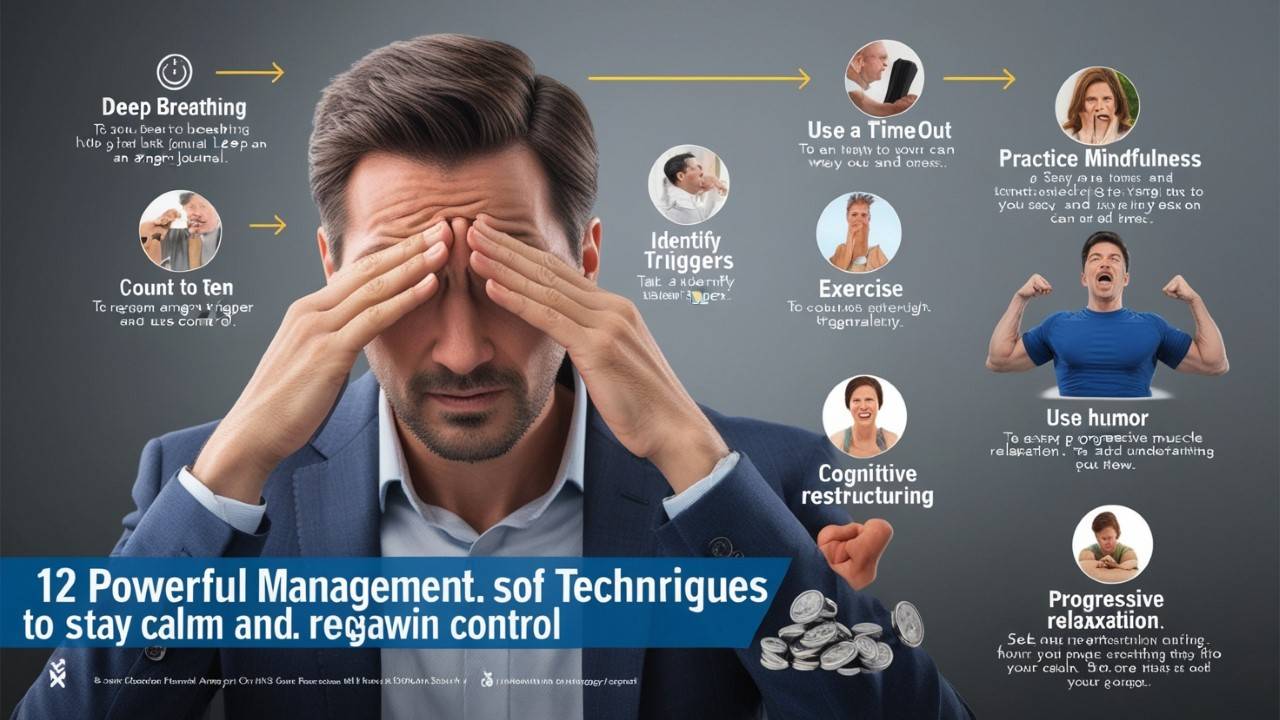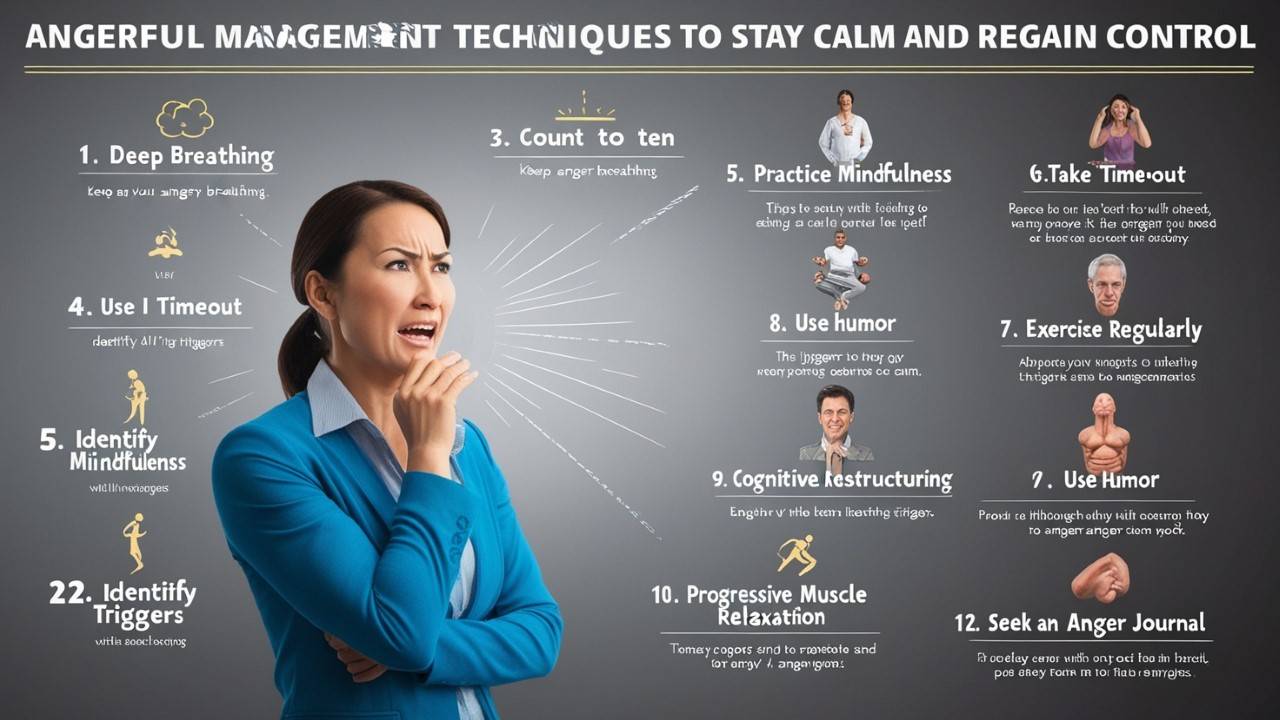Anger Management: 12 Powerful Techniques to Stay Calm and Regain Control
Discover 12 powerful anger management techniques to stay calm in any situation. Learn to control your emotions and improve your relationships today.
Quick Summary:

Struggling with anger? Here are 12 quick techniques to regain calm:
- Deep breathing
- Count to ten
- Use “I” statements
- Take a timeout
- Identify triggers
- Practice mindfulness
- Exercise regularly
- Use humor
- Cognitive restructuring
- Progressive muscle relaxation
- Seek professional help
- Keep an anger journal
Introduction: Anger Management

Anger management is a crucial skill that can significantly improve your quality of life and relationships. In today’s fast-paced world, learning to control your emotions is more important than ever. This comprehensive guide will walk you through 12 powerful anger management techniques that can help you stay calm and regain control in challenging situations.
Top 12 Powerful Techniques for Anger Management

As someone who has personally struggled with anger issues and worked with others to overcome similar challenges, I can attest to the effectiveness of these techniques. Let’s dive into each method and explore how you can implement them in your daily life.
1. Deep Breathing: The Foundation of Anger Management
Anger management often begins with something as simple as taking a deep breath. When we’re angry, our breathing becomes shallow and rapid, exacerbating our stress response. By consciously slowing down and deepening our breath, we can activate the body’s relaxation response.
How to practice deep breathing:
- Inhale slowly through your nose for a count of 4
- Hold your breath for a count of 4
- Exhale slowly through your mouth for a count of 6
- Repeat this cycle 5-10 times
I’ve found that practicing deep breathing regularly, even when I’m not angry, has made it easier to use this technique in the heat of the moment. It’s like building a muscle – the more you practice, the stronger and more automatic the response becomes.
2. Count to Ten: A Simple Yet Effective Anger Management Tool
The age-old advice to count to ten when you’re angry isn’t just a cliché – it’s a proven anger management technique backed by psychology. Counting creates a mental distraction and gives you a moment to pause before reacting.
How to use this technique effectively:
- As soon as you feel anger rising, start counting slowly in your head
- Focus on each number and visualize it in your mind
- Take a deep breath with each count
- If you’re still feeling angry after reaching ten, start over
I remember a time when I was stuck in terrible traffic and felt my anger building. I started counting, and by the time I reached ten, I realized how pointless it was to be angry about something I couldn’t control. This simple technique helped me shift my perspective and calm down.
3. Use “I” Statements: Communicating Effectively in Anger Management
Anger management isn’t just about controlling your emotions – it’s also about communicating them effectively. Using “I” statements instead of “You” statements can help prevent conflicts from escalating.
Examples of “I” statements:
- Instead of: “You never listen to me!” Try: “I feel frustrated when I don’t feel heard.”
- Instead of: “You’re always late!” Try: “I feel disrespected when plans aren’t kept.”
In my experience, using “I” statements has not only helped me manage my anger but has also improved my relationships. It allows me to express my feelings without putting others on the defensive.
4. Take a Timeout: Creating Space in Anger Management
Sometimes, the best anger management technique is to simply remove yourself from the situation. Taking a timeout gives you space to cool down and process your emotions.
How to take an effective timeout:
- Recognize when you need a break
- Communicate clearly that you need some time to calm down
- Remove yourself from the situation for at least 10-15 minutes
- Use this time to practice other anger management techniques
- Return to the situation when you feel calmer and more in control
I’ve found that taking timeouts has prevented many arguments from escalating. It’s important to communicate that you’re not avoiding the issue, but taking time to address it more constructively.
5. Identify Triggers: Proactive Anger Management
One of the most effective anger management strategies is to identify your anger triggers. By understanding what sets you off, you can either avoid these triggers or prepare yourself to handle them better.
Steps to identify your anger triggers:
- Keep an anger journal (more on this later)
- Note the circumstances when you get angry
- Look for patterns in situations, people, or events that trigger your anger
- Reflect on why these triggers affect you so strongly
I discovered that lack of sleep was a major trigger for my anger. By prioritizing my sleep, I’ve significantly reduced my angry outbursts.
6. Practice Mindfulness: Cultivating Awareness in Anger Management
Mindfulness is a powerful anger management tool that helps you stay present and aware of your emotions without getting caught up in them.
How to practice mindfulness for anger management:
- Set aside time each day for mindfulness meditation
- Focus on your breath or bodily sensations
- When angry thoughts arise, acknowledge them without judgment
- Gently bring your attention back to the present moment
I was skeptical about mindfulness at first, but after consistently practicing for a few weeks, I noticed a significant improvement in my ability to manage anger. It’s like developing a superpower of emotional awareness.
7. Exercise Regularly: Physical Activity as an Anger Management Tool
Regular exercise is not only successful for your physical health but also an excellent anger management technique. Physical activity releases endorphins, which can improve your mood and reduce stress.
Effective exercises for anger management:
- Aerobic activities like running, cycling, or swimming
- High-intensity interval training (HIIT)
- Martial arts or boxing (with proper guidance)
- Yoga or Tai Chi for a mind-body approach
I’ve found that a quick run or even a brisk walk can significantly reduce my anger levels. It’s like the physical act of moving forward helps me mentally move past my anger.
8. Use Humor: Lightening the Mood in Anger Management
Humor can be a powerful tool in anger management. It helps shift your perspective and releases tension. However, it’s important to use humor appropriately and not to belittle others or avoid addressing issues.
Ways to incorporate humor:
- Find the absurd or funny aspect of a frustrating situation
- Watch a funny video or read jokes when you feel anger building
- Practice laughing at yourself (in a kind way) when you make mistakes
I remember a time when I was furious about a work situation. A colleague made a silly joke, and suddenly, I found myself laughing. It completely diffused my anger and allowed me to approach the problem more constructively.
9. Cognitive Restructuring: Changing Thoughts in Anger Management
Cognitive restructuring is a technique used in cognitive-behavioural therapy that can be very effective for anger management. It involves identifying and challenging angry thoughts and replacing them with more balanced, rational ones.
Steps for cognitive restructuring:
- Identify the thought causing anger (e.g., “They’re doing this on purpose to annoy me”)
- Challenge the thought (e.g., “Is there evidence for this? Could there be another explanation?”)
- Replace with a more balanced thought (e.g., “They might not realize how this affects me”)
This technique has been a fundamental change for me. By questioning my angry thoughts, I’ve often realized that my initial reactions were based on assumptions rather than facts.
10. Progressive Muscle Relaxation: Physical Approach to Anger Management
Progressive Muscle Relaxation (PMR) is a physical technique that can help with anger management by reducing overall tension in your body.
How to practice PMR:
- Start with your toes, tensing the muscles for 5 seconds
- Release the tension and notice the feeling of relaxation
- Move up through your body, tensing and relaxing each muscle group
- End with the muscles in your face and head
I practice PMR regularly before bed, and it’s helped me become more aware of physical tension throughout the day. When I notice tension building, it’s often a sign that I need to address some underlying anger or stress.
11. Seek Professional Help: Expert Guidance in Anger Management
Sometimes, despite our best efforts, we need professional help with anger management. There’s no shame in seeking support from a therapist or counsellor who specializes in anger issues.
When to consider professional help:
- Your anger feels out of control
- You’ve hurt others (physically or emotionally) because of your anger
- Anger is affecting your relationships or career
- You’re using substances to cope with anger
I resisted seeking help for a long time, thinking I should be able to handle my anger on my own. When I finally saw a therapist, I gained invaluable insights and tools that I wish I’d learned years earlier.
12. Keep an Anger Journal: Self-Reflection in Anger Management
Keeping an anger journal is an excellent anger management technique that can help you identify patterns, triggers, and progress over time.
What to include in your anger journal:
- Date and time of the angry episode
- What triggered the anger?
- How you feel physically and emotionally
- What you did do in response
- Reflection on how you could have handled it differently
My anger journal has been eye-opening. It’s helped me recognize triggers I hadn’t noticed before and track my progress in implementing other anger management techniques.
Frequently Asked Questions
Is it normal for a 14-year-old to have anger issues?
While some degree of emotional volatility is common in teenagers because of hormonal changes and developmental stages, persistent anger issues in a 14-year-old should be addressed. It’s important to distinguish between normal teenage moodiness and more serious anger problems. If anger is interfering with daily life, relationships, or school performance, it’s advisable to seek help from a mental health professional who specializes in adolescent issues.
What medication is used for anger?
There is no specific medication designed solely for anger management. However, if anger is a symptom of an underlying mental health condition, such as depression, anxiety, or bipolar disorder, medications may be prescribed to treat these conditions. Common medications that I think will help include:
- Antidepressants (SSRIs like fluoxetine or sertraline)
- Anti-anxiety medications (benzodiazepines, but these are typically for short-term use)
- Mood stabilizers (like lithium or valproic acid)
It’s crucial to consult with a psychiatrist or qualified healthcare provider before considering any medication for anger issues. Medication should typically be used in conjunction with therapy and lifestyle changes for the best results.
How can I help my child with uncontrollable anger?
Helping a child with uncontrollable anger requires patience, consistency, and often professional support. Here are some strategies:
- Model quelled behaviour and healthy anger management techniques
- Establish clear, consistent rules, and consequences for aggressive behaviour
- Teach and practice anger management techniques together (like deep breathing or counting to ten)
- Encourage open communication about feelings
- Identify triggers and work on coping strategies
- Ensure your child gets enough sleep, exercise, and a balanced diet
- Consider family therapy or individual therapy for your child
- Work with your child’s school to ensure a consistent approach
- In severe cases, consult with a child psychiatrist about potential underlying issues
Remember, progress may be slow, but with consistent effort and support, most children can learn to manage their anger more effectively.
How to help a family member with anger issues?
Supporting a family member with anger issues can be challenging, but here are some ways you can help:
- Encourage them to seek professional help, such as therapy or anger management classes
- Learn about anger management techniques yourself and share this knowledge
- Set clear boundaries about what behaviour is and isn’t acceptable
- Avoid engaging when they’re amid an angry outburst
- Practice active listening when discussing their anger issues
- Recognize and praise their efforts to manage anger better
- Suggest stress-reducing activities you can do together, like exercise or meditation
- Be patient – changing ingrained behaviour patterns takes time
- Take care of your mental health and seek support if needed
- In cases of physical violence or abuse, prioritize safety and seek immediate help
Remember, while you can offer support, ultimately, the person with anger issues must take responsibility for managing their emotions and behaviour.
Conclusion:
Anger management is a journey, not a destination. By implementing these 12 powerful techniques, you can gain better control over your emotions and improve your relationships and overall well-being. Remember, it’s okay to feel angry – it’s a normal human emotion. The goal is to express and manage that anger in healthy, constructive ways.
Thank you for taking the time to read this comprehensive guide on anger management. I hope you find these techniques as helpful as I have in my journey to better emotional control.
Recommended Reading:
- Calm the Storm: 19 Powerful Stress Reduction Techniques
- Deep Breathing Meditation Exercise Related Mental Physical Health
- World Meditation Day: A Global Celebration of Mindfulness and Inner Peace



